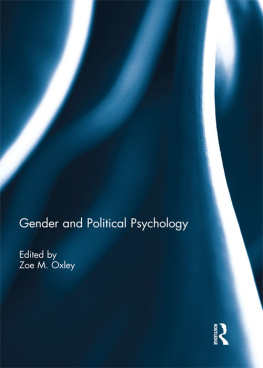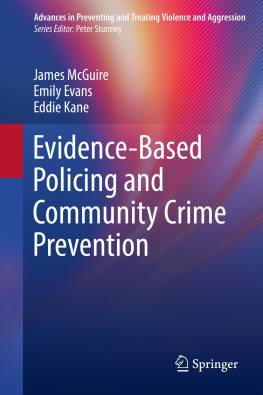Editors
Brian H. Bornstein
Department of Psychology, University of Nebraska-Lincoln, Lincoln, NE, USA
Monica K. Miller
Department of Criminal Justice, Interdisciplinary Social Psychology Ph.D. Program, University of Nevada, Reno, Reno, NV, USA
ISSN 2366-6099 e-ISSN 2366-6102
Advances in Psychology and Law
ISBN 978-3-030-11041-3 e-ISBN 978-3-030-11042-0
https://doi.org/10.1007/978-3-030-11042-0
Library of Congress Control Number: 2018966437
Springer Nature Switzerland AG 2019
This work is subject to copyright. All rights are reserved by the Publisher, whether the whole or part of the material is concerned, specifically the rights of translation, reprinting, reuse of illustrations, recitation, broadcasting, reproduction on microfilms or in any other physical way, and transmission or information storage and retrieval, electronic adaptation, computer software, or by similar or dissimilar methodology now known or hereafter developed.
The use of general descriptive names, registered names, trademarks, service marks, etc. in this publication does not imply, even in the absence of a specific statement, that such names are exempt from the relevant protective laws and regulations and therefore free for general use.
The publisher, the authors and the editors are safe to assume that the advice and information in this book are believed to be true and accurate at the date of publication. Neither the publisher nor the authors or the editors give a warranty, express or implied, with respect to the material contained herein or for any errors or omissions that may have been made. The publisher remains neutral with regard to jurisdictional claims in published maps and institutional affiliations.
This Springer imprint is published by the registered company Springer Nature Switzerland AG
The registered company address is: Gewerbestrasse 11, 6330 Cham, Switzerland
Brian H. Bornstein
Monica K. Miller
Preface
We are very pleased to offer the fourth volume in the Advances in Psychology and Law book series. The initial vision for the series was to contribute to the law-psychology field by providing a book series that publishes thorough reviews of existing research alongside the empirical works legal and policy implications. The three previous volumes have done that, and the series is now well established as a reliable source of comprehensive and up-to-date information on a broad array of psycholegal topics.
This volume contains nine chapters, each focusing on a different topic within psychology and law. Each chapter provides a thorough but focused review of the legal issue, including a discussion of relevant statutes, case law, and legal procedures, as well as a synthesized review of the psychological research and its application to the relevant legal issues. Authors for each chapter conclude by identifying possible reforms and gaps in the literature that are ripe for further investigation.
The volumes first three chapters address topics related to criminal suspects. First, Kaplan and colleagues, in , focus on the earliest stage of suspect-legal system interaction: the interrogation. They are especially interested in the role of coercion in suspect interrogations and how to evaluate it. The chapter considers individual differences in suspect vulnerability to the coercive pressures of interrogation, particularly with respect to youth and intellectual disability. The authors propose a new psychometric framework for measuring and quantifying coercion in investigative interviews and interrogations and review their own nascent research on the proposed instrument.
A frequent topic during interrogations is whether the suspect has an alibi. The chapter, , by Charman and colleagues, reviews the current state of the literature on the psychology of alibis. They discuss the processes and problems associated with both alibi generation, by suspects themselves, and alibi evaluation, by law enforcement, jurors, and others. The chapter advances the theoretical understanding of the alibi generation and evaluation processes, and encourages researchers to adopt a system variables approach to maximize the impact of alibi research.
The last chapter on suspects, by Henderson and Levett on , zeroes in on a later stage in the processnamely, plea bargaining. Their emphasis shifts somewhat, focusing primarily on defense counsels role in the plea-bargaining process. The chapter provides a theoretical background to understand how the attorneys advice and role likely influence a suspect/defendants decision to accept a guilty plea offer. It then examines the research examining legal and extra-legal factors that influence the type of advice an attorney gives a client contemplating a guilty plea offer, considering the implications of this research for the current standards used to define effective representation.
The chapter, , by Douglass and Smalarz, addresses post-identification feedback, an increasingly important topic in the realm of eyewitness identification. The post-identification feedback effect has been featured in court cases around the country and has served as justification for reform recommendations intended to enhance the reliability of eyewitness identification evidence. The chapter reviews the extant literature on the post-identification feedback effect, discusses the role of post-identification feedback research in court decisions and legislated eyewitness identification procedures, and examines the relationship between post-identification feedback and system variable reform recommendations.
The next two chapters address issues related to gender, sexual orientation, and the legal system. The chapter, , by Livingston and colleagues, explores the many and varied ways that gender relates to perceptions and outcomes at trial. The authors consider the gender of many participants involved in trials: litigants (especially criminal defendants); victims; attorneys; expert witnesses; and fact finders (i.e., judges and jurors). The chapter provides overarching theoretical psychological explanations for the observed effects of gender using the symbolic interactionist framework, gender roles, and the influence of expectations and stereotypes. This analysis includes a discussion of factors that might moderate or mediate gender effects at trial.
Plumm and Leighton, in their chapter , look at gender from a different perspectivethat of the victim, in the context of hate crimes based on gender. The chapter also covers hate crimes based on sexual orientation. In identifying the current state of the literature on sexual orientation and gender bias motivated violent crimes, the authors consider whether hate crimes committed against members of the LGBTQ community differ from hate crimes involving other victim characteristics (e.g., race), and they discuss the policy implications for this expanding category of criminal statutes.










